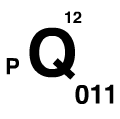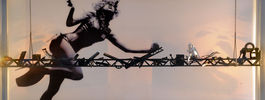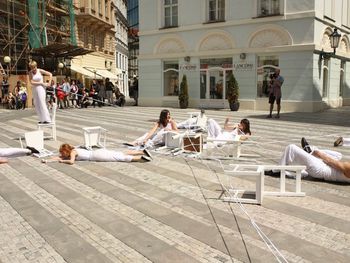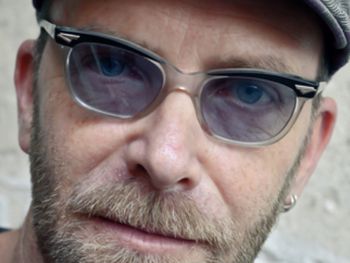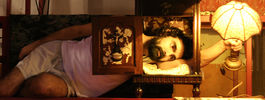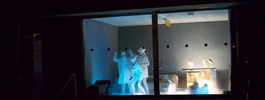Czechoslovak scenography presented itself to the world public in a complex historical survey at the Biennial of Sao Paulo in 1959 and in a number of monographic exhibitions devoted to the work of Vlastislav Hofman, František Tröster, Josef Svoboda, Jan Sládek, Josef Gabriel, Ladislav Vychodil and many other significant artists in almost all European and non- European cultural centres. Everything that can be said of its historical development has thus already been said and we therefore feel that it would be more important to mention at least briefly the state, tendencies and problems of the contemporary work, which served as a decisive criteria in evaluating the individual works as well as drawing up the general concept of this exhibition. The overall picture of the Czechoslovak exhibit is to a certain extent distorted by the absence of three of our most outstanding artists, František Tröster, Josef Svoboda and Ladislav Vychodil who according to the Prague Quadrennial cannot as the winners of the Sao Paulo Biennial participate in this competition, and also due to the fact that the Czechoslovak exhibit as a whole has been excluded from international competition and can compete with the other national exhibits only unofficially. Due to these circumstances the exhibit is more in the nature of a review along the tendencies outlined by the I. National Review of Czechoslovak Stage Design, held in Brno in 1960. Certainly this exhibit is not one of those chosen for the Theatre Biennial in Sao Paulo which was marked by a certain topical theme with the individual exhibits acting as documents of these tendencies and not exhibits in themselves as in the case of paintings. The present exihibit dangerously resembles such exhibits of paintings and the individual items on exhibit somehow take on the aspect of paintings. These are two of the „shortcomings" of this exhibit caused by objective reasons which we found necessary to mention before going on to discuss present trends in the sphere of stage design. An analysis will determine two main trends in contemporary scenography: The first of these is based on the results of the work of our prewar avantgarde of the thirties its aim being the work with lights, motion, time and space as dramatic factors, which is being considered the constanta, the specificity which differentiates scenography from the traditional form of art, from painting, sculpture and architecture. If present-day scenography rejects the means and methodical processes of this „traditional" form of art, the reasons differ from those of the twenties of this century, when the prevailing slogan was one of „pure" art. Theory thus considered the unsurmountable limits of material means which divide the various fields of art from each other, and of the common aims which on the contrary join them together. However, for the present state of art — observing the validity of the second part of the thesis - the penetration of one field of art into another is characteristic, a fact which holds true even more so for the sphere of material means: sculpture joins painting, literature joins graphic art, the stage combines with films, etc. The contact of scenography with the other fields of art thus acquires a new characteristic independent of traditional processes while at the same time scenography in this sense has a particular task - it returns creative art impulses of a higher form which it had adopted itself and is in turn influenced by it all over again. It thus achieves something which new art cannot do: it has a more pregnant function, sense and purport as well as a new shape. The second trend of contemporary scenography strictly rejects the building up of dramatic space, which it considers an artificially constructed supershape, it rejects illusionism in any form and tries to discover the elementary essense of scenographic work, searching for the function of a bare stage and the role of props. The stage remains a stage, a theatricial architectural element necessary for the actor's acting who plays a functional role. No need to stress that this trend is essentially an analytic one and its purpose resembles the ideas on which the constructivism of the twenties was based. In the early stage of its genesis we find instances where the constructivist scheme, either in the structure of the scene, the choice of props or the arrangement is actually repeated in the formal aspect. When speaking of analysis as one of the characteristic, even elemental property of this trend we add that analysis is only the first, initial phase of its work method, which is negated immediately by the second, synthetic phase. The entire process of disintegration and the immediate new linking unfolds in front of the eyes of the spectator. It is a process of creation, of constant appearance and disappearance which is the specific trait of stage art, activising, the spectator and theatrical creativeness, resulting in the immediate contact of the actor and spectator which differentiates the stage from films and television.
- Helena Bezáková
Additional information: Born in 1936 at Oponice. Studied at tne School of Industrial Art and at the Academy of Musical and Dramatic Arts in Bratislava under prof. L. Vychodil, L. Purkyňová and prof. J. Mudroch. Since 1962 she was at work for the State Theatre in Košice, and since 1966 she has been working for the Slovák National Theatre in Bratislava as costume designer. Her most important works are costume designs to Hamlet and to Romeo and Juliet by W. Shakespeare, to Atlantis by V. Nezval, to Dances and Tears by Zvon, to The Tragedy of Man by I. Madách, to Lady Macbeth and Aida by G. Verdi, to Norma by V. Bellini and to Svatopluk by E. Suchoň. She has collaborated also with the National Theatre in Prague, the Opera of the State Theatre in Brno, with the theatres in Ostrava, Olomouc, Košice, Banská Bystrica and in Prešov; abroad with the theatres in Sofia, Novi Sad, Rzeszów. She co-operated with the Czechoslovak Television in Bratislava. With her costume designs she took part in a number of scenographic exhibitions at home and abroad.
Obrázky z katalogu
- Květoslav Bubeník
Additional information: Born in 1922 in Kostelec na Hané. He has been working as a stage designer at the National Theatre in Prague. He participated in the PQ in 1967, 1971, 1975 (Silver Medal for the stage design) and in 1979. Artist of Merit.
Obrázky z katalogu
- Pavel Mária Gábor (Pavol Gábor)
Additional information: Born in 1929 at Lest near Zvolen. Studied at the Slovak Technical College (special line of architecture), then stage design at the Academy oi Musical and Dramatic Arts in Bratislava under prof. L. Vychodil. Since 1954 he co-operates with a large number of theatres in Czechoslovakia, for instance with the National Theatre of Prague, the State Theatre in Brno, The New Scene in Bratislava, the J. Záborský Theatre in Prešov, the State Theatre in Košice. From his former works the best designs include the stage sets to Stoneflower, Hiroshima, An American in Paris, A Midsummer Nighťs Dream, Queen of Spades, and from the most recent ones then the décors to Rienzi, André Chénier, Power and Glory, Greek Passion, Samson and Dalila. As to productions of musico-dramatic works ne has collaborated with stage directors M. Fischer, J. Gyermek, K. Tóth, J. Nekvasil at the Slovak National Theatre in Bratislava, the State Theatre in Košice and at the State Theatre in Ostrava. He has participated in all inland exhibitions of contemporary scenographic creation, and abroad in the exhibitions of Rio de Janeiro, Santiago de Chile, Bucharest, Budapest, Warsaw and of Casablanca.
Obrázky z katalogu
Exhibiting works
-
: (Hiroshima),
Slovenské národní divadlo
(Slovak National Theatre),
1964
-
: (A Masked Ball),
Slovenské národní divadlo
(Slovak National Theatre),
1964
- Ján Hanák
Additional information: Born in 1931 in Bánovce nad Bebravou. He has been working as a stage designer at the State Theatre in Košice. He participated in 1965 in the Czechoslovak exhibition at the Biennial of Fine Arts in Sao Pauto which was awarded a Gold Medal. He took part in the PQ in 1967 1971 1975 and in 1979.
Obrázky z katalogu
- Milan Hložek
Additional information: Born in 1929 at Kelcice near Prostějov. Since 1951 he is at work as scenic designer at the SNP Theatre in Martin. He co-operates as non-staff member with numerous Slovak theatres as well as with Czech theatres e. g. in Hradec Králové, České Budějovice, Ostrava, Olomouc, Uherské Hradiště; abroad with theatres in Lvov, Rieka and with some theatres in the German Democratic Republic. His most important works include the décors to the Optimistic Tragedy by Víshnievski, Jan Hus by J. K. Tyl, Dances and Tears by P. Zvon, Three Sisters by A. P. Chekhov, A Midsummer Nighťs Dream by W. Shakespeare, Of Mice and Men by J. Steinbeck, The Lower Depths by M. Gorky and Rosenkrantz and Guildenstern Are Dead by T. Stoppard. He organized one-man exhibitions in Martin and Lvov. He has participated in all Czechoslovak exhibitions of applied arts, of industrial decorative arts and of scenic design. He took part in the Prague Quadrennial 1967. Abroad he exhibited his works in Budapest, Vienna, Cairo and in Sao Paulo.
Obrázky z katalogu
- Luboš Hrůza
* 1933-03-28, Jihlava
Additional information: Born 1933 in Jihlava (ČSFR). Stage and costume designer. Since 1969 he has been living
in Norway and working at the National Theatre in Oslo, first as a stage designer, now as
chief stage designer. Lecturer at the State Theatre School and at the School of Architecture
in Oslo. He took part in the Prague Quadrennial 1967, where he awarded a silver medal for
stage design.
Obrázky z katalogu
Exhibiting works
-
: (Mandragora),
Činoherní klub
1966
-
: (Crime and Punishment ),
Činoherní klub
1966
- Štefan Hudák
Additional information: Born in 1942 in Velký Šariš. Since 1968 he has been working as an architect at the Czechoslovak Television Studio in Košice. He participated in the PQ in 1971, 1975 and in 1979.
Obrázky z katalogu
- Zbyněk Kolář
Additional information: Born in 1926 in Opava. He has been working as a stage designer at the Vinohrady Theatre in Prague. He participated in the PQ in 1967, 1971, 1975 and in 1979.
Obrázky z katalogu
- Mikuláš Kravjanský
Additional information: Born 1928 in Rudňany. Graduated from the School of Stage Design at the Academy of Music and Drama in Bratislava, where he studied under prof. L. Vychodil. From 1957-1960 he worked as stage designer at the J. Záborský Theatre in Prešov and at present he is the head architect of Czechoslovak television in Bratislava. He has participated in many exhibitions of stage design at home as well as abroad in Sao Paulo, Paris, Havana, Cairo and Budapest.
Obrázky z katalogu
- Jan Kropáček
Additional information: Born 1920 in Prague. Studied at the School of Graphic Art and at the School of Actors of E. F. Burian. After the closing down of this school he worked as actor and designer for the East Bohemian Theatre at Pardubice, the Municipal Theatre in Kladno and ihe Vetrnik scene in Prague. Since 1946 he has been working for the Grand Opera of the 5th of May in Prague and since 1948 as costume designer of the National Theatre. He cooperates with almost all Czechoslovak theatres and recently also with Czechoslovak films. Until now he has designed costumes for more than 500 productions. He has worked primarily with stage directors O. Krejča, V. Kašlík, A. Radok and J. Pleskot. He has lectured at the Academy of Music and Drama on the history of costumes and has published a number of articles on this topic in professional publications.
Obrázky z katalogu
- Vladimír Nývlt
Additional information: Born in 1927. Studied architecture at the Arts and Crafts College in Prague. After having completed his studies in 1951, he started work at the Army Artistic Theatre in Prague. Since 1960 he has been at work as décor chief of the E. F. Burian Theatre in Prague. He collaborates with a number of theatres in Czechoslovakia and also with several theatres in the F.R.G. He is a permanent collaborator of the Czechoslovak State Film and of the Czechoslovak Television.
Obrázky z katalogu
Exhibiting works
-
: (From the House of Death),
Národní divadlo
(National Theatre),
1964
- Irena Nývltová
Additional information: Born in 1926 in Prague. Graduate of the State Graphic School and the School of Applied Art in Prague - section applied painting. Since 1952 non-staff member of the Army Art Theatre, for which she designs programmes and posters, since 1953 costume designer and two years later joins the staff. She mainly cooperated with the directors E. F. Burian, K. Novák and O. Krejča. Her most significant stage sets are: The Rat-Catcher, White Nights, Věra Lukášova, The Rhinoceros, Rose Tatoo and End of the Carnival. She participated in the I. Exhibition of Czechoslovak Stage Design in Brno, in the Biennial in Sao Paulo, in Rio de Janeiro, in Berlin (GDR), Sofia, Budapest and London.
Obrázky z katalogu
- Čestmír Pechr
Additional information: Born in 1926 at Mladá Boleslav. Studied under prof. Mokrý and Baláž at the State School of Graphic Arts and the special line of applied painting under prof. J. Novák at the Arts and Crafts College in Prague. Since 1955 stage designer of the Slovak National Theatre in Bratislava. His creation aims predominantly at applied graphic art, above all at posters, at book graphic art and at exhibition concerns. Among his significant scenographic realizations are sets to The Physicists, Elopement to Silence, Hamlet, A Streetcar Named Desire, Where the Foxes Say Good-night, Don Carlos, Our Swaggerers. He has participated in all Slovak exhibitions of applied art and of decorative industrial arts in Bratislava, abroad in exhibitions of contemporary art ín Vienna, Budapest and Berlin. He organized one-man exhibitions of film and theatre posters in Bratislava (Little Scene of the Slovak National Theatre in 1963, C. Majerník Gallery in 1970; 10 years of posters of the Slovak National Theatre) and in Vienna in 1970.
Obrázky z katalogu
- František Perger
Additional information: Born in 1937 in Kružlovská Huť. In 1962 he graduated from the Academy of Performing Arts in Bratislava where he studied stage design under prof. L. Vychodil. Since 1962 he works as a stage designer at the Regional Theatre in Nitra. He also collaborates with other theatres, among them the New Stage Theatre in Bratislava, The J. G. Tajovský Theatre in Zvolen, the theatre at Uherské Hradiště, The Theatre of the Slovak National Uprising in Martin and with Czechoslovak Television. He has worked as a guest designer in Bulgaria in the Yordan Yavkov Theatre in Tolbukhin and has participated in exhibitions in the USSR, Hungary, Sweden, Brazil, Cuba, Egypt, Paris, Warsaw and Berlin. He has also exhibited at the Prague Quadrennial in 1967, 1975, 1979 and 1991.
Information from catalogue 1999:
Currently operates as director of set design in Andrej Bagar Theatre in Nitra and co-operates with other Slovak theatres, TV and film.
Obrázky z katalogu
- Vladimír Půhoný
Additional information: Born 1937 in České Budějovice. Studied at the School of Fine Arts in Prague, at the School of Industrial Arts, monumental painting under prof. A. Fišárek and at the School of Stage Design of prof. F. Tröster at the Academy of Music and Drama in Prague. In 1966 he started to work for the Theatre of the Working People at Gottwaldov as stage designer. Among his most important works are the sets for Don Juan by M. Frisch, The Emperoťs Mime by V. Renč and the adaptation of J. Otčenášek's novel Romeo, Juliet and Darkness.
Obrázky z katalogu
- Ludmila Purkyňová
Additional information: Born in 1928 in Hradec Králové. She has been working as a costume designer at the Slovak National Theatre in Bratislava. She is an associate professor at the Department of Stage Design at the Academy of Performing Arts in Bratislava. She participated in the PQ in 1967 (Gold Medal for costumes), 1971, 1975 and in 1979. Artist of Merit.
Obrázky z katalogu
Exhibiting works
-
: (Spring of 71),
Slovenské národní divadlo
(Slovak National Theatre),
1962
- Michael Romberg
Additional information: Born in 1918. Studied at the School of Applied Art in Prague, in the specialized class of prof. F. Kysela, from 1936-1942. He is teaching at the Academy of Music and Drama in Prague, at the Chair of Scenography. Among his outstanding créations are the costumes for Gogol's Wedding, The Wolves and Sheep by A. N. Ostrovski, The Enemies and Wassa Zheleznova by M. Gorki. He is cooperating with the National Theatre in Prague, the Oldřich Stibor in Olomouc, the State Theatre in Ostrava and also with other theatres. He also devotes himself to graphic art (book illustrations). He had independent exhibitions in 1943, 1946, 1949, 1963 and 1964. He is at present exhibiting his works in Italy.
Obrázky z katalogu
- Zdeněk Seydl
Additional information: Born in 1916 at Třeboň. Apprenticeship as typographer. He completed studies at the School of Graphic Arts and at the Arts and Crafts College in Prague /special line of monumental painting under prof. F. Kysela/. Predominantly he works as commercial artist and book illustrator, and collaborates with the puppet and animated film. To his significant theatrical works belong the designs for The War and for The Opera of the Country Fair in E. F. Burian's production, for The Defeat at the Tyl Theatre in Prague, for Dalskabáty at the Central Theatre of the Czechoslovak Army in Prague, for the ballet Faust at the Smetana Theatre, The Firebird, The Talkative Slug and for the Mother Courage at the National Theatre in Prague. At the Prague Quadrennial in 1967 he received a Silver Medal for his costume designs for Stravinsky's Petrouchka. Among his most important recent designs are Amphitryon, Hadrián z Římsů and An Optimistic Tragedy at the National Theatre in Prague, The Bag-pipe Player from Strakonice at the Vinohrady Theatre in Prague and Love in Carneval Colours at the Laterna Magica in Prague.
Obrázky z katalogu
Exhibiting works
-
Igor Stravinsky: (Petroushka),
Národní divadlo
(National Theatre),
1962
- Otakar Schindler
Additional information: Born in 1923 in Stará Plesná. He has been working as a chief stage designer at the Zdeněk Nejedlý Realistic Theatre in Prague. He exhibited in the PQ in 1967, 1971, 1975 and in 1979.
Obrázky z katalogu
Exhibiting works
-
: (Closely Guarded Trains),
Divadlo Petra Bezruče
1966
- Bořivoj Slavík
Additional information: Born in 1930 at Vyškov. Studied under prof. Hoffmeister at the College of Applied Art in Prague. Since 1954 he was at work at the Workers' Theatre in Gottwaldov and then at the Regional Theatre in Nitra. Since 1970 he acts as architect of the Czechoslovak Television in Bratislava. His most important works include scenic sets to Forty Scoundrels and One Little Innocent by O. Daněk, Desire under the Elms by 0'Neill, The Hangman and the Madman by Voskovec and Werich. He has participated in a number of exhibitions at home and abroad (in Hungary, Poland, Yugoslavia, FRG, Cuba and in Brazil).
Obrázky z katalogu
- Vladimír Suchánek
Additional information: Born in 1934 in Gbely. He has been working as a stage designer at the Slovak National Theatre in Bratislava. He exhibited in the PQ in 1967 (Silver Medal for stage design), 1971, 1975 (Silver Medal for stage design) and in 1979 (Silver Medal for stage design).
Obrázky z katalogu
Exhibiting works
-
: (Idiot),
Slovenské národní divadlo
(Slovak National Theatre),
1965
- Vladimír Šrámek
Additional information: Born in 1927 in Prague. Graduated from the Academy of Musical and Dramatic Arts, the scenographic class of prof. Fr. Tröster. Since 1950 he acts as décor chief of the State Theatre in Ostrava. He realized there sets for dramas, opéras, operettas and also for ballets, collaborating within the recent years predominantly with the stage directors R. Koval, M. Nekvasil and V. Hamšík. To his most important designs belong the stage sets for Richard III, After the Fall, Médea, Saint Joan, Julius Caesar, The Seagull and The Shrewd. He took part in a number of exhibitions at home and abroad. As co-author he has participated in the publication Richard III, an analysis of the staging at the State Theatre in Ostrava. He is a permanent collaborator of the Czechoslovak Television.
Obrázky z katalogu
- Vojtěch Štolfa
Additional information: Born in 1921 in Kojetín. He has been working as a resident stage designer at the State Theatre in Brno. He participated in the PQ in 1967, 1971, 1975 and in 1979.
Obrázky z katalogu
- Otto Šujan
Additional information: Born in 1930 in Zvolen. Studied the special line of architecture at the Slovak Technical College and stage design at the College of Musical and Dramatic Arts under prof. L. Vychodil where he completed studies in 1955. After having graduated he started work at the J. Záborský Theatre in Prešov, since 1956 he has been engaged by the New Scene in Bratislava where he is working up to this date. He co-operates as an ex-staff member with a number of Slovak theatres and with the Czechoslovak Television. His most important designs include the stage sets to tbe Periphery by Langer, Mamzelle Nitouche by Hervé, Hello, Dolly! by Stewart-Herman, The Threepenny Opera by Brecht, and from among the most recent ones The Emperoťs New Habiliments by Beneš, the West Side Story by Bernstein, The Karamasoff Brothers by Dostojevsky, The Lark by Anouilh. He acts as expert assistant of the Chair of scenic design under prof. L. Vychodil at the College of Musical and Dramatic Arts in Bratislava. He has participated in a number of scenic design exhibitions at home and abroad such as the Biennial In Sao Paulo in 1965, the exhibition of Slovák scenography in the Paris Odeon Theatre, the exhibitions of stage and costume design in the USA, ín Vienna, Leningrad, Havana, Cairo, Budapest, Paris, Chicago and in Warsaw.
Obrázky z katalogu
- Miloš Tomek
Additional information: Born in 1921 in Prague. After having completed his studies at the Arts and Crafts School in Prague, he collaborated as scenic designer with stage director V. Vaňátko at the Theatre of Young Pioneers, and subsequently passed over to the Workers' Theatre in Gottwaldov. Between 1950 and 1962 he was chief designer of the State Theatre in Brno. In 1954 he was awarded the State Prize for his décor to the play Stalingrad. To his most important designs belong the stage sets for Mysteria Buffa, The Ascent of Arturo Ui, The Assassination of Marat and Julius Caesar, which he has realized in a collaboration with stage director E. Sokolovský. With stage director A. Hajda he co-operated on the staging of Woyzeck and The Trial of the Muromskis. At present he is stage designer of the theatre Divadlo na Vinohradech. Externally he co-operates with a number of Czechoslovak theatres.
Obrázky z katalogu
- Karel Vaca
Additional information: Born in 1919 at Prostějov. Between 1945 and 1950 he studied at the Arts and Crafts College, at the studio of monumental painting under prof. E. Filla. In addition to painting he illustrates books, designs film and theatre posters, and is at work as stage and costume designer.
Obrázky z katalogu
Exhibiting works
-
: (The Girl of Thebes),
Národní divadlo
(National Theatre),
1967
- Stanislava Vaníčková
Additional information: Born in 1927 in Prague. She cooperates as costume designer with the Slovak National Theatre and with the New Stage Theatre in Bratislava. She took part in the PQ in 1967, 1971, 1975 (Silver Medal for costumes) and in 1979 (Silver Medal for costumes).
Obrázky z katalogu
- Adolf Wenig
Additional information: Born in 1912 in Prague. In 1935 he graduated from the Academy of Fine Arts; between 1939 and January 1978 he was the chief stage designer of the Municipal Theatres of Prague. He has designed more than 400 stage sets and costumes, the most important of which are Tyl' s The Shoemakers' Fair, Shaw' s Androcles and the Lion and a number of Shakespearean productions. He often works as a specialized costume designer and is the foremost representative of this specialization in our theatres /Jeppe of the Hill, The Pretenders, The Lentern/. He has colleborated also with a number of domestic and foreign theatres and often elso with films and television. In 1962 he received the title of Artist of Merit for his life-long contribution to the theatre. He has exhibited in a number of collective, as well as one-men exhibitions. At the Biennial in Sao Paulo in 1961 he represented Czechoslovak costume designs, he also participated in the Prague Quadrennial in 1967, in 1971 /where he received a Silver Medal for costume designs/ and in 1975. He most recent one-man exhibition was held in Prague in 1974.
Obrázky z katalogu

